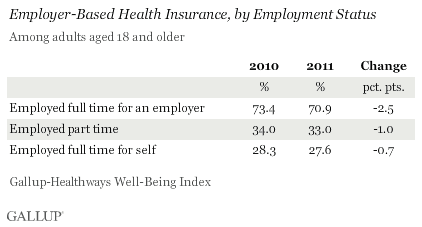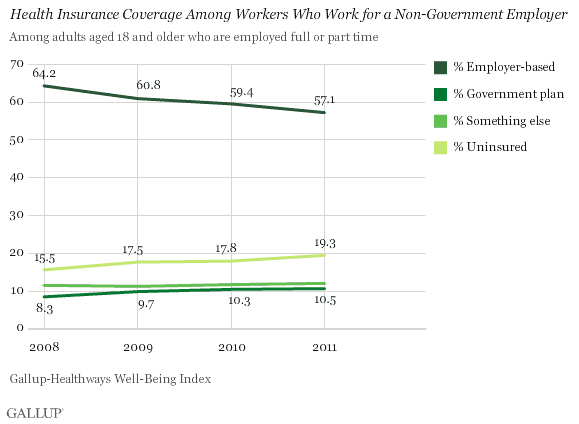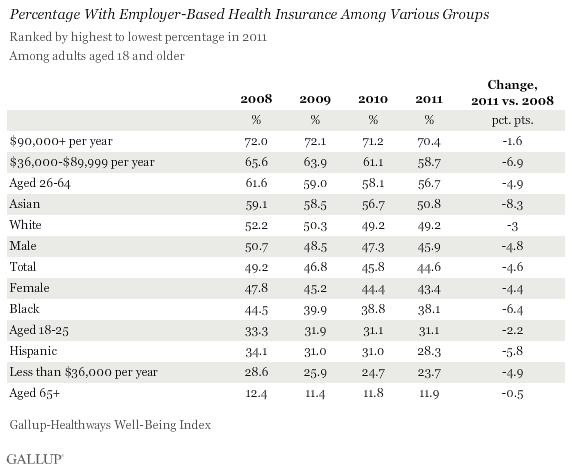This is the second article in an in-depth series on the state of health insurance coverage in America. The first article looked at the nation's uninsured in detail.
WASHINGTON, D.C. -- Fewer Americans got their health insurance from an employer in 2011 (44.6%) than in 2010 (45.8%), continuing the downward trend Gallup and Healthways have documented since 2008. As employer-based health insurance has declined, the percentage of Americans who are uninsured has increased, rising to 17.1% this year, the highest seen since 2008.

The 25.2% of Americans who had government health insurance -- Medicare, Medicaid, or military/veterans' benefits -- is unchanged from 2010, but remains slightly elevated compared with 2008 and 2009 levels. The percentage of Americans who report they receive healthcare through some other means, which would include buying their own coverage, has been stable over the past four years.
Two factors appear to be driving up the percentage of uninsured Americans. First, more Americans were unemployed or underemployed in 2011 than in 2008. Second, fewer employees had health insurance from their employer, which may be because employers no longer offered it or the cost was too high for employees to afford.
Gallup finds a decrease in employer-based insurance since 2010 regardless of whether Americans were employed full time by an employer, employed full time for themselves, or working part time.

Among workers who do not work for the government, the majority (57.1%) get their health insurance from their employer, but this percentage has also decreased steadily since 2008. Increasing percentages now say they are uninsured or get their healthcare from a government plan such as Medicare, Medicaid, or military/veterans' benefits.

Employer-Based Healthcare Declines Across Groups
Employer-based health insurance declined among most major population subgroups last year, with the exception of young adults and seniors. It is also down significantly compared with 2008 across all groups.
High-income Americans are by far the most likely to say they get their health insurance from an employer, with 70.4% doing so in 2011. Low-income Americans are among the least likely to have employer-based health coverage, at 23.7%.
Young adults (31.1%) and Hispanics (28.3%) are also far less likely than most groups to get their health insurance from an employer.

Bottom Line
The percentage of Americans who have employer-based health insurance has been declining since 2008 and has dropped to a low of 44.6% this year. At the same time, more Americans are now uninsured and more are insured through a government program.
Increased unemployment is likely a factor in declining levels of employer-based health insurance, but is not the sole cause. It appears that even Americans who are in the workforce -- both full- and part-time employees -- are becoming less likely to get their health insurance from their employer. This could be for one of two reasons, and is likely a combination of both: either some workers can no longer afford the rising cost of the health insurance the employer offers or the employer is simply not offering health insurance any longer. Additionally, the proportion of the U.S. workforce that is composed of part-time workers -- a group less likely to receive employer-based health insurance than full-time workers -- has increased.
Healthcare costs are continuing to rise rapidly, affecting individuals, employers, and the government. The average annual premium for employer-sponsored family health insurance coverage increased to $15,073 last year, up 9% from 2010, according to a 2011 Kaiser Family Foundation survey. The survey found workers contributed $4,129 on average to the premium cost and employers $10,944.
If this trend continues, it is likely that the percentage of Americans who get their health insurance from their employer will continue to decline. Whether more Americans then become uninsured or are able to gain access to coverage may be largely reliant on the fate of the healthcare law.
About the Gallup-Healthways Well-Being Index
The Gallup-Healthways Well-Being Index tracks well-being in the U.S., U.K., and Germany and provides best-in-class solutions for a healthier world. To learn more, please visit well-beingindex.com.
Survey Methods
Results are based on telephone interviews conducted as part of the Gallup-Healthways Well-Being Index survey Jan. 1-Dec. 31, 2011, with a random sample of 353,492 adults, aged 18 and older, living in all 50 U.S. states and the District of Columbia, selected using random-digit-dial sampling.
For results based on the total sample of national adults, one can say with 95% confidence that the maximum margin of sampling error is ±0.2 percentage point.
For results based on subgroups, one can say with 95% confidence that the maximum margin of sampling error is ±1 percentage point.
Interviews are conducted with respondents on landline telephones and cellular phones, with interviews conducted in Spanish for respondents who are primarily Spanish-speaking. Each sample includes a minimum quota of 400 cell phone respondents and 600 landline respondents per 1,000 national adults, with additional minimum quotas among landline respondents by region. Landline telephone numbers are chosen at random among listed telephone numbers. Cell phone numbers are selected using random-digit-dial methods. Landline respondents are chosen at random within each household on the basis of which member had the most recent birthday.
Samples are weighted by gender, age, race, Hispanic ethnicity, education, region, adults in the household, and phone status (cell phone only/landline only/both, cell phone mostly, and having an unlisted landline number). Demographic weighting targets are based on the March 2010 Current Population Survey figures for the aged 18 and older non-institutionalized population living in U.S. telephone households. All reported margins of sampling error include the computed design effects for weighting and sample design.
In addition to sampling error, question wording and practical difficulties in conducting surveys can introduce error or bias into the findings of public opinion polls.
For more details on Gallup's polling methodology, visit www.gallup.com.
